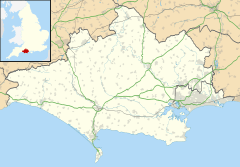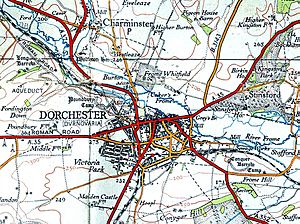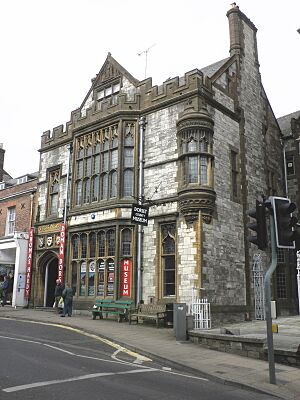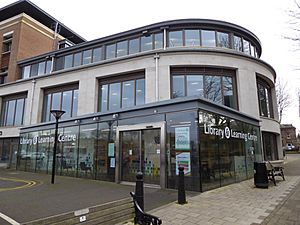Dorchester, Dorset facts for kids
Quick facts for kids Dorchester |
|
|---|---|
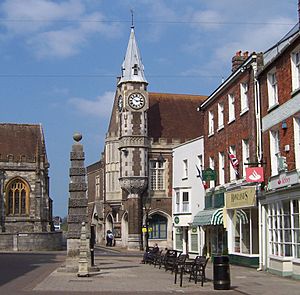 Town Pump and Municipal Buildings |
|
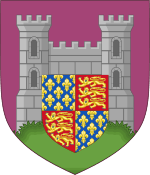 Coat of arms of Dorchester |
|
| Population | 21,366 (2021 Census) |
| OS grid reference | SY690906 |
| • London | 116 miles (187 km) NE |
| Civil parish |
|
| Unitary authority |
|
| Ceremonial county | |
| Region | |
| Country | England |
| Sovereign state | United Kingdom |
| Post town | DORCHESTER |
| Postcode district | DT1 |
| Dialling code | 01305 |
| Police | Dorset |
| Fire | Dorset |
| Ambulance | South Western |
| EU Parliament | South West England |
| UK Parliament |
|
| Website | Dorchester Town Council |
Dorchester (/ˈdɔːrtʃɛstər/ DOR-ches-tər) is the main town of Dorset, England. It sits between Poole and Bridport on the A35 road. This old market town is located by the River Frome. It is south of the Dorset Downs and north of the South Dorset Ridgeway. This ridgeway separates Dorchester from Weymouth, which is about 7 miles (11 km) south. The town area includes the new community of Poundbury and the part called Fordington.
People first lived in this area a very long time ago. The Romans built a camp here after beating the Durotriges tribe. They called their new town Durnovaria. They also built an aqueduct to bring water and an amphitheatre on an old British earthwork. During the Middle Ages, Dorchester became an important place for business and politics. It was where the famous "Bloody Assizes" trials happened. These trials were led by Judge Jeffreys after the Monmouth Rebellion. Later, the trial of the Tolpuddle Martyrs also took place here.
Many famous people have lived in Dorchester. The author Thomas Hardy lived here for many years. He was inspired by the town and used a made-up version of Dorchester in his novel The Mayor of Casterbridge. Dorchester has many old and important buildings. In the 2011 census, Dorchester had a population of 19,060 people. It is a key place for jobs, schools, shops, fun activities, and healthcare for the area. It has six industrial areas, the Dorset County Hospital, a weekly market, and a high school. The town also has a football club, a rugby club, several museums, and the Dorchester Festival, which happens every two years.
Contents
History of Dorchester
Ancient Times: Prehistory and Romans
Dorchester's story goes back to very old times. The first people lived about 2 miles (3.2 km) southwest of today's town centre. This was near Maiden Castle, a huge Iron Age hill fort. It was one of the strongest settlements in Britain before the Romans arrived. Different tribes lived there starting from 4000 BC. The Durotriges tribe was likely living there when the Romans came in 43 AD.
The Romans defeated the local tribes by 70 AD. They built a military camp that grew into a town called Durnovaria. This name came from a local word meaning 'place with fist-sized pebbles'. It also seems to have been partly named after the Durotriges tribe. Durnovaria became a busy market town for the countryside. It was an important road junction and a stopping place for travelers. It also became one of the two main towns for the Celtic Durotriges tribe.
You can still see parts of the Roman walls that once surrounded the town. Most of these walls are now walking paths called 'The Walks'. A small piece of the original wall remains near the Top 'o Town roundabout.
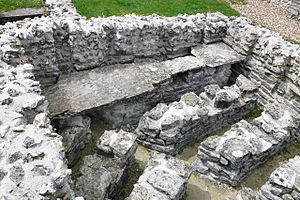
Other Roman remains include the foundations of a town house near the county hall. When new buildings are constructed, Roman items are often found. For example, in 1936, 22,000 Roman coins from the 3rd century were found in South Street. Other Roman discoveries include silver and copper coins, a gold ring, and a bronze statue of the Roman god Mercury. Large areas of tessellated pavement (mosaic floors) have also been found.
The Dorset Museum has many Roman objects on display. The Romans built an aqueduct to bring water to the town. This aqueduct was found again in 1900. It was a channel cut into the chalk hills. The water source is thought to be the River Frome, about 12 miles (19 km) upstream from Dorchester. Near the town centre is Maumbury Rings, an old British henge (a circular earthwork). The Romans changed it to use as an amphitheatre. To the northwest is Poundbury Hill, another old fort from before the Romans.
There is not much proof that people continued to live here after the Romans left Britain. The Roman name Durnovaria changed to Durngueir in Old Welsh. This name was written down in the 9th century. The area stayed under British control until the mid-7th century. The Roman cemetery nearby was still used. Some people think Dorchester might have been the centre of a small kingdom or power base.
Middle Ages
One of the first Viking attacks in England might have happened near Dorchester around 790 AD. A writer from that time said that the King's officer, called a reeve, gathered some men. He thought the Vikings were just merchants from another country. When he met them, he told them to go to the royal town. But the Vikings then killed him and his men.
By 864 AD, the Saxons controlled the area around Durnovaria. They called themselves Dorsaetas, which means 'People of the Dor'. The old local name was probably Dorn-gweir, which became Dornwary in Old English. The town then became known as Dornwaraceaster or Dornwaracester. This name combined 'Dor/Dorn' from Latin and Celtic languages with 'cester', an Old English word for a Roman station. Over time, this name became Dorncester/Dornceaster and then Dorchester.
When the Norman Conquest happened in 1066, Dorchester was not a very important place. The Normans did build a castle, but it is no longer there. A priory (a religious house) was also started in 1364, but it has also disappeared. In the later Middle Ages, the town grew. It became a busy place for trade and politics in south Dorset. It had a strong textile (cloth) industry that lasted until the 17th century. In the time of King Edward III (1312–1377), the town was run by bailiffs and burgesses. The number of burgesses grew to fifteen by the time of King James I (1566–1625).
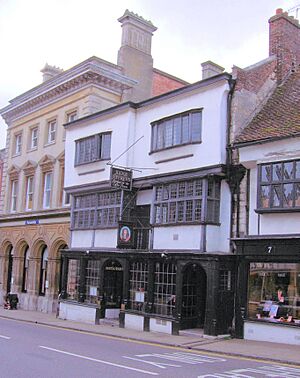
Early Modern Period
In the 17th and 18th centuries, Dorchester had several big fires. In 1613, a candle maker's pot got too hot and started a fire. In 1622, a malt maker caused another fire. In 1725, a fire began in a brewery. And in 1775, a soap boiler started a fire. The 1613 fire was the worst. It destroyed 300 houses and two churches.
Only a few of the town's very old buildings are still standing today. These include Judge Jeffreys' lodgings and a Tudor almshouse (a house for poor people). Many new buildings were built in the Georgian style. These include the Shire Hall, which is made of Portland stone. The municipal buildings were built in 1848. They include the old corn exchange and town hall.
In the 17th century, Dorchester was a centre for Puritans moving to America. The local church leader, John White, helped set up the settlement of Dorchester, Massachusetts. The first attempt was at Cape Ann, but the land was not good. The colony moved to what is now Salem. In 1628, the group received a special paper from the King. The Massachusetts Bay Company was formed, and many colonists went to America. John White is sometimes called the uncelebrated founder of the Massachusetts Bay Colony.
During the English Civil War in 1642, Dorchester was strongly defended against the Royalists. Dorset was known for people changing sides often. In 1643, 2,000 Royalist troops attacked the town. Its defences were not strong enough, and it quickly gave up. But the town was not badly damaged. It stayed under Royalist control for some time, but the Puritans eventually took it back.
In 1685, the Duke of Monmouth tried to invade England, but he failed. This was called the Monmouth Rebellion. Almost 300 of his men were sentenced to death or sent away to other countries. This happened in the "Bloody Assizes" trials, led by Judge Jeffreys. The trials took place in the Antelope Hotel in Dorchester.
Modern Dorchester
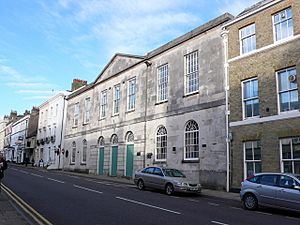
In 1833, the Tolpuddle Martyrs started the Friendly Society of Agricultural Labourers. Even though Trade unions were legal, these men were arrested. This was because they swore a secret oath to join the society. They were tried in the Shire Hall. Below the courtroom are cells where prisoners waited for their trials. Dorchester Prison was built in the town in the 1800s. It held prisoners from local courts until it closed in December 2013. There are now plans to build homes and a museum on the site.
Dorchester stayed a small town within its old walls until the late 1800s. This was because the land around it was owned by the Duchy of Cornwall. This land was part of the Manor of Fordington. Some buildings were put on this land, like military barracks in 1794 and a workhouse in 1835. Railways and stations were also built in 1847 and 1857.
The Duchy land was farmed in an old way until 1874. Then, it was divided into three large farms. After this, many important things happened for the town. Poundbury hillfort was opened for public enjoyment in 1876. A new market area was created in 1877. The Recreation Ground opened in 1880. The Eldridge Pope Brewery was built in 1881. Salisbury Field was kept for public use in 1892. Land was bought in 1895 for the Borough Gardens. The clock and bandstand were added there in 1898.
A permanent military base, the Depot Barracks, was built in the town in 1881. The High West Street drill hall was also created around this time. New housing areas were built outside the old town walls. These included the Cornwall Estate from 1876 and the Prince of Wales Estate from 1880. The Victoria Park Estate began building in 1897. The lime trees in Queen's Avenue were planted in February 1897.
Poundbury is a new part of Dorchester built to the west. It started in 1993 and is designed like a traditional village. It is on land owned by Charles III (when he was Prince of Wales). It will eventually have 2,500 homes and about 6,000 people. Charles was very involved in designing this area.
In 2008, Dorchester became Dorset's first Official Transition Initiative. This is part of a movement where communities work together to respond to challenges like climate change.
Geography of Dorchester
Dorchester town centre is about 55 to 80 metres (180 to 262 ft) above sea-level. It is on gently sloping ground next to the south bank of the River Frome. It is about 7 miles (11 km) north of Weymouth. It is also about 18 miles (29 km) southeast of Yeovil and 20 miles (32 km) west of Poole. The town's built-up area spreads south, west, and southeast. To the north and northeast, the river's floodplain and watermeadows limit growth.
The land directly south and west of the town is part of the Dorset National Landscape area. The South Dorset Ridgeway path crosses this area. There are over five hundred ancient sites along the chalk hills of the ridgeway. These include burial mounds, stone circles, and hillforts. Many old objects found here are shown at the Dorset Museum in Dorchester.
The ground under the town is made of chalk from the Late Cretaceous period. In some places, there are newer Quaternary deposits on top. These include a layer of clay-with-flints on the western edge of town around Poundbury. There is also alluvium in the river's floodplain.
Dorchester's Economy
In 2012, 17,500 people worked in Dorchester. More than half (51%) worked full-time. Most jobs (57%) were in public services, education, and health. 18% were in professional services like finance and ICT. 17% were in shops, hotels, and restaurants. 4% were in making things, and 2% in building. The unemployment rate in July 2014 was very low, at 0.9% of people aged 16–64.
Dorchester has six industrial estates. These are The Grove Trading Estate, Poundbury Trading Estate, Marabout Barracks, Great Western Centre, Railway Triangle, and Casterbridge Industrial Estate. These areas mostly have light factories, wholesalers, and service businesses. Big employers in the town include Dorset County Council, Dorset County Hospital NHS Foundation Trust, and Tesco.
In 2008, the Dorchester BID (Business Improvement District) was set up. Its goal is to promote the town and make it better for businesses. Most local businesses (84%) voted for it. The BID is paid for by a fee from businesses in the town. It works on projects like helping businesses, improving safety, promoting the town, and making it look nicer. In June 2018, the Dorchester BID was voted in for a second time.
The Brewery Square project has brought new shops, homes, restaurants, a hotel, and cultural places. The Dorchester South railway station is also being improved. It will become the UK's first solar-powered railway station. The Charles Street development has a new library, adult education centre, and offices for Dorset Council. Future plans for this area include shops, an underground car park, a hotel, and affordable homes.
People in Dorchester
In the 2011 census, Dorchester civil parish had 8,996 homes. There were 8,449 households and a total population of 19,060 people. About 48% of residents were male and 52% were female. 17% of residents were under 16 years old. This is a bit lower than the average for England (18.9%). Also, 22.4% of residents were 65 or older. This is higher than the average for England (16.4%).
Culture in Dorchester
Writers and Poets

The famous novelist and poet Thomas Hardy based his fictional town of Casterbridge on Dorchester. His novel The Mayor of Casterbridge is set there. Hardy's childhood home is east of the town. His town house, Max Gate, is owned by the National Trust and you can visit it. Hardy is buried in Westminster Abbey, but his heart was buried in Stinsford.
William Barnes, a poet who wrote in the West Country dialect, was a church leader near Dorchester for 24 years. He also ran a school in the town. There are statues of both Hardy and Barnes in the town centre. Barnes's statue is outside St. Peter's Church, and Hardy's is by the Top o' Town crossroads.
John Cowper Powys's novel Maiden Castle (1936) is also set in Dorchester. Powys wanted it to be a rival to The Mayor of Casterbridge. Powys lived in Dorchester as a child and later as an adult. A plaque marks his former home on High East Street.
Arts and Museums
Dorchester Arts is based in an old school building. It puts on music, dance, and theatre shows. It also runs art projects for groups who might not usually get involved. Every two years, it hosts the Dorchester Festival. Dorchester Arts is an important arts organisation. Since 2015, Dorchester Arts has been based at the corn exchange.
Dorchester has several museums. These include the Roman Town House, the Dinosaur Museum, the Terracotta Warriors Museum, the Dorset Teddy Bear Museum, the Keep Military Museum, Dorset Museum, and the Tutankhamun Exhibition. All these museums took part in "Museums at Night" in May 2011, when museums across the UK opened after dark. The Shire Hall, where the Tolpuddle Martyrs were tried, opened as a museum in 2018. The Durnovaria Silver Band practices in Fordington Methodist Church Hall.
British sculptor Elisabeth Frink lived and worked in Dorset from 1976 until she passed away in 1993. You can see her artwork around Dorchester. Examples include the Dorset Martyrs Memorial sculpture and the Frink Collection at the Dorset Museum.
Important Buildings
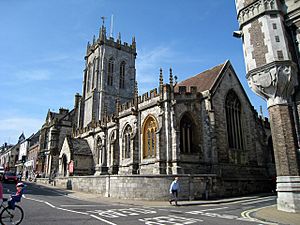
In Dorchester parish, there are 293 buildings that are listed by Historic England. This means they are important for their history or architecture. Five of them are Grade I listed, which is the highest level. These are the Church of St George, the Church of St Peter, Max Gate, the Roman town house, and Shire Hall.
The Church of St George has a south door from the late 1000s. It has a carved stone panel above the door showing St George with soldiers. The south aisle and part of the porch are from the 1100s. The Church of St Peter was mostly built in 1420–1421. It has a 12th-century doorway that was moved. There are many important monuments inside. Thomas Hardy helped with adding the vestry and chancel in 1856–7.
Max Gate was designed by Thomas Hardy himself in the Queen Anne style. It was his home until he died in 1928. It was built in 1885. The remains of the Roman house near the county hall are from the early 300s AD. It has a hypocaust (underfloor heating system) and mosaic floors. It is the only Roman town house you can see in Britain. The current Shire Hall building was designed by Thomas Hardwick and built in 1797. It is made of Portland stone.
A special plaque remembers the sentencing of the Tolpuddle Martyrs here in 1834. The building was used as a court until 1955. Thomas Hardy was a judge here, and his experiences inspired his writing. The building looks much the same as it did in the 1800s. In 2014, plans were approved to turn it into a heritage centre and tourist attraction.
Education and Healthcare
Dorchester has thirteen first schools and three middle schools: St Osmund's Church of England Middle School, St Mary's Church of England Middle School, Puddletown and Dorchester Middle School. It also has one upper school, The Thomas Hardye School. This school was started in 1569. It was given money by Thomas Hardye, a merchant, in 1579. The author Thomas Hardy, who was a distant relative, was a school governor there. In February 2023, the school had 2,103 students. The nineteen schools in the Dorchester area work together as the Dorchester Area Schools Partnership (DASP). There is also a private school called Sunninghill Prep School.
Kingston Maurward College is a college for land-based studies just outside the town. It offers many courses, including farming, gardening, and wildlife management.
The town's hospital is Dorset County Hospital on Williams Avenue. It has a twenty-four-hour emergency department. Services are provided by the Dorset County Hospital NHS Foundation Trust.
Sports and Fun Activities
Dorchester Town F.C., the town's football team, plays in the Southern League Premier Division. Famous players like Harry Redknapp and former England players Graham Roberts and Martin Chivers played for 'The Magpies' (Dorchester's nickname) in the late 1970s and early 1980s. The club's home ground is the Avenue Stadium, which was built in the early 1990s.
Dorchester RFC is an amateur rugby union team. They play in the Dorset & Wilts South 1 League. Dorchester Cricket Club plays in the Dorset Premier League. They were champions in 2009.
A new leisure centre and swimming pool opened on Coburg Road in 2012. It cost over £8 million to build.
In May 2009, a skatepark opened in Dorchester. It is at the corner of Maumbury Road and Weymouth Avenue. It took 12 years of planning and building to create.
Transport in Dorchester
The town has two railway stations:
- Dorchester South is on the main line to London Waterloo. It also connects to Bournemouth, Southampton Central, and Weymouth. South Western Railway runs these services. As part of new building work, it will become the first solar-powered railway station in the UK.
- Dorchester West was designed by Isambard Kingdom Brunel. It is on the Heart of Wessex Line. Great Western Railway runs trains from here. It connects the town with Yeovil Pen Mill, Bath Spa, Bristol Temple Meads, and Gloucester.
The town is on the A35, a main road that goes to Poole in the east and Honiton in the west. The A37 road goes north to Yeovil. The A352 road goes north to Sherborne. And the A354 road goes south to Weymouth. A bypass road was built south and west of the town in 1988. This helps traffic avoid the town centre. The A35 often gets very busy because it is a main route to the southwest.
Buses are run by First Hampshire & Dorset. Important routes include service 10 to Weymouth and service X51 to Bridport. Damory Coaches and South West Coaches also run local and regional services. National Express and Megabus offer long-distance coach trips. You can go to places like London Victoria and Weymouth from Dorchester.
Media
Local radio stations for Dorchester include Greatest Hits Radio Dorset, BBC Radio Solent, and community radio station Keep 106. Keep 106 started from the County Hospital's hospital radio station. Local TV news comes from BBC South Today and ITV Meridian. Dorchester's local newspaper is the Dorset Echo.
Many homes in Dorchester have access to fast internet services. The town is part of a project to increase fast internet availability in the county, which has been completed.
Famous People from Dorchester
- Frances Bagenal, (born 1954), a professor who studies planets and space at the University of Colorado Boulder.
- Orlando Bailey, a rugby player for Bath Rugby, was born here and went to Thomas Hardye School.
- Paul Blake (born 1990), a Paralympic athlete.
- James Campbell (born 1988), a cricketer, was born in the town.
- Aaron Cook (born 1991), a taekwondo athlete who competed in the 2008 Olympic Games. He was born and went to school in Dorchester.
- Julian Fellowes (born 1949), a member of the House of Lords, novelist, screenwriter, actor, and producer. He produced TV shows like Downton Abbey.
- Thomas Hardy (1840–1928), a famous novelist and poet. He trained as an architect and lived in the town until he died at his home, Max Gate.
- Paul Hillier (born 1949), a classical singer and composer, was born in Dorchester. He went to The Thomas Hardye School.
- Henry Moule (1801–1880), a church leader in Fordington from 1829. He invented the dry earth closet.
- Llewelyn Powys (1884–1939), a novelist and essayist, was born in Dorchester.
- Henry Pyrgos (born 1989), a Scottish International rugby player, was born in the town.
- Tom Roberts (1856–1931), an Australian painter, was born in Dorchester.
- Sir Frederick Treves (1853–1923), a surgeon to King Edward VII. He was born in the town and is buried at St Peter's Church.
- Lettice D'Oyly Walters (1880–1940), a poet and editor.
- Kirsty Way (born 1998), a trampoline gymnast, was born in Dorchester.
- Norrie Woodhall (1905–2011), an actress, was born in Dorchester.
- Sam Hoskins (born 1993), an English professional footballer, was born in the town. He plays as an attacking midfielder for Northampton Town.
Twin Towns
Dorchester is twinned with three towns in Europe:
- Bayeux in France, since 1959. This is because the Dorset Regiment were the first soldiers to enter Bayeux in 1944 at the end of the Second World War.
- Lübbecke in Germany, since 1973. This twinning started when the Durnovaria Silver Band met a German music group in Bayeux in 1968.
- Holbæk in Denmark, since 1992. This twinning came from a shared interest in community plays. Actors from both towns have performed in each other's communities.
The schools in Dorchester are also twinned with schools in Europe, Africa, and Asia. The Thomas Hardye School has partnerships with schools in Tanzania, Dehradun, and Bayeux.
Freedom of the Town
Sir Frederick Treves was given the Freedom of the Town of Dorchester in July 1902. Thomas Hardy received this honour on November 15, 1910.
Images for kids
See also
 In Spanish: Dorchester (Dorset) para niños
In Spanish: Dorchester (Dorset) para niños


